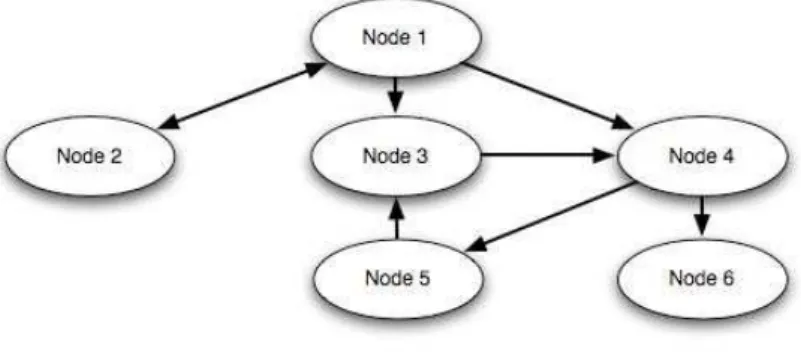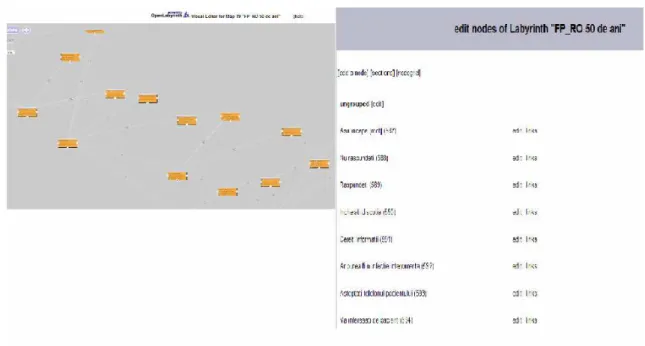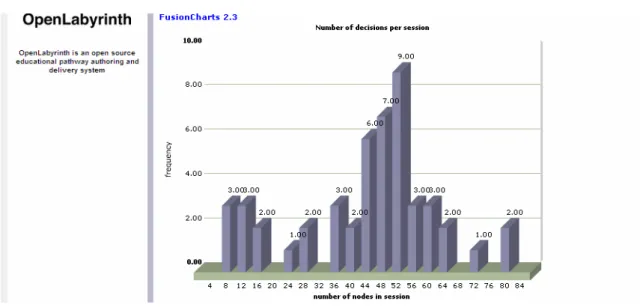Open Labyrinth – a Web Application for Medical Education
Using Virtual Patients
Tudor C
Ă
LINICI
*, Valentin MUNTEAN
“Iuliu Haţieganu” University of Medicine and Pharmacy Napoca, 13 Emil Isac, 400023 Cluj-Napoca, Cluj, Romania.
E-mail(s): tcalinici@umfcluj.ro
* Author to whom correspondence should be addressed; Tel.: +4-0264-431697.
Received: 10 November 2010 /Accepted: 5 December 2010 / Published online: 15 December 2010
Abstract
The aim of this paper is to present an application, implemented and used at “Iuliu Hatieganu” University of Medicine and Pharmacy Cluj Napoca for medical education, The application, called Open Labyrinth is an open source, web based application, developed using ASP technology, very useful for medical education using virtual patients technology. All the virtual patients developed using this application are MedBiquitos compliant. This application was implemented at University of Medicine and
Pharmacy “Iuliu Haţieganu” Cluj-Napoca, part of eVip Project. There were developed four virtual
patients, three of them were included in eVip database. The user friendly interface, the compliance with the standards, the level of IT knowledge request for the case developers make this application a useful tool for medical education at the clinical level.
Keywords:Virtual patients; Medical education; Labyrinths; eVip.
Introduction
One of the goals in medical education on undergraduate level is to enable the students to identify and solve clinical problems. For this, the students must interact with the patients, and this experience is blended with traditional lectures and small group tutorials. But the issues of safety, the legislation, the patients punctual reactions, limit this interaction, and because of this, the medical education for the students in not the best that could be offer.
A solution for this is to use simulations instead of real patients. One of the most suitable technologies for this is the use of virtual patients. Virtual Patients are interactive computer applications that simulate real-life clinical scenarios, providing an effective way for the healthcare professionals or medical students to not only learn of clinical topics but also to practice in a virtual and therefore safe environment [1].
The Application
Figure 1. A diagram of a simple Open Labyrinth map with six nodes
Considering the navigational model, a virtual patient designed in Open Labyrinth could be represented by a graph consisting of nodes interconnected by edges representing the potential decisions of the learner. Completing a case requires choices to be made at key scenario points with the consequences of these choices affecting the final path through the case [3].
The virtual patients developed using Open Labyrinth are conform with the MedBiquitous Virtual Patients Specifications [4].
The implementation of Open Labyrinth was part of eVip: Electronic Virtual Patient Project, founded under eContentplus Programme [5,6], project in which University of Medicine and Pharmacy “Iuliu Hatieganu” was partner. This application was the second virtual patient application implemented at the University, after the successful implementation of Web-Sp application [7], part of the same project.
Being a web based application written using Active Server Pages technology for installing Open Labyrinth it was necessary a proper Microsoft based server, having Microsoft Windows 2003 Server as operating system and Microsoft SQL Server 2005 as database server. The application was running in Internet Information Services and it was necessary to use a ODBC connector to join to the database.
Before using the application, each user has to log in using a username and a password, and depending of the user’s role in application (student or map creator), the user can perform different actions. Figure 2 shows the interface for a user who has the labyrinth creator role.
There are four different ways to create a labyrinth, as it is shown in figure 3: starting from zero, importing a MedBiquitous compatible virtual patient, importing a VUE map or duplicating an existing labyrinth.
At its core, the Visual Understanding Environment (VUE) is a concept and content mapping application, developed to support teaching, learning and research and for anyone who needs to organize, contextualize, and access digital information. Using a simple set of tools and a basic visual grammar consisting of nodes and links, the users can map relationships between concepts, ideas and digital content [8].
The application’s interface is very user friendly and intuitive, the user didn’t has to have advanced IT knowledge, only to have basic skills about internet navigation. Each object of the map can be accessed using a direct link, visually represented, directly from the labyrinth’s main page – Figure 4.
Each node could be very easy identified, using lists or visual representation of the labyrinth – Figure 5 and the application has a HTML editor on which the user can edit the content of the node.
The implementation of Open Labyrinth at University of Medicine and Pharmacy Iuliu Haţieganu is
Figure 2. Open Labyrinth interface
Figure 5. Two ways of identifying nodes into a labyrinth
The Use of the Application
Since the ending of the implementation, there were developed four virtual patients, and three of them were included in the eVip project database. More then 100 users were enrolled and the four virtual
patients were used for the course of Medical Education, for the students in 4th year, Faculty of Medicine.
More information about the patients are presented in the table 1
Table 1. Virtual patients details
VP
No VP Description
No
nodes Language
Accessed by (no. of sessions)
Included on eVip Referatory
1
Male patient 50, years old, Lower limb infection, infectious endocarditis and sepsis in a male with diabetes
60 Romanian 99 Yes
2 Female patient, 61 years old, patient
complaining of back and knee ache 44 English 24 Yes
3 Female patient, 61 years old, with
hypercalcemia and parathyroid tumor 44 Romanian 49 Yes
4 Female patient, unknown age, serious
tumor 13 English 9 No
Figure 6. Graphical representation of the number of decision per session
Figure 7. Graphical representation of a session
Conclusions
In conclusion, the use of Open Labyrinth is a very good application for medical education using the virtual patients technology, and the implementation of this application was a success. More than 100 students used this application. The students seems to enjoy most the caser written in Romanian languages, the two patients in Romanian language being accessed four more times that the two virtual patients in English language.
As well, the very user friendly interface made possible the use of the application by the persons who have basic IT skills (in fact, only internet browsing skills are mandatory).
Because of the generality of the labyrinths, this application could be use to describe multiple pathologies, being easy to be integrated in University curricula for different courses, at the medical level.
from: URL: http://labyrinth.mvm.ed.ac.uk/documents/labyrinth_userguide.pdf
4. Zary N, Hege I, Heid J, Woodham L, Donkers J, Kononowicz A, Enabling Interoperability,
Accessibility and Reusability of Virtual Patients across Europe - Design and Implementation, Medical Informatics in a United and Healthy Europe, K.-P. Adlassnig et al. (Eds.), IOS Press, 2009. pp. 826-830.
5. Azan B, Smothers V, ANSI /MEDBIQ VP.10.1-2010 MedBiquitous Virtual Patient Player
Specifications and Description Document. [online] 2010 [Accessed November 2010]. Available
from: URL:
http://www.medbiq.org/working_groups/virtual_patient/VirtualPatientPlayerSpecification.pdf
6. eVip Project. [online] [Accessed November 2010]. Available from: URL:
http://www.virtualpatients.eu/
7. Europe’s Information Society – Thematical Portal: eVip. [online] [Accessed November 2010].
Available from: URL:
http://ec.europa.eu/information_society/apps/projects/factsheet/index.cfm?project_ref=ECP-2006-EDU-410030
8. Călinici T, Muntean V., Achimaş A. WebSp- Informatics Application for Training in the Medical
Domain. Applied Medical Informatics 2007;21(3,4):69-72.
9. 7 things you should know about... Data Visualization, EsuCase 2009. [online] [Accessed November



